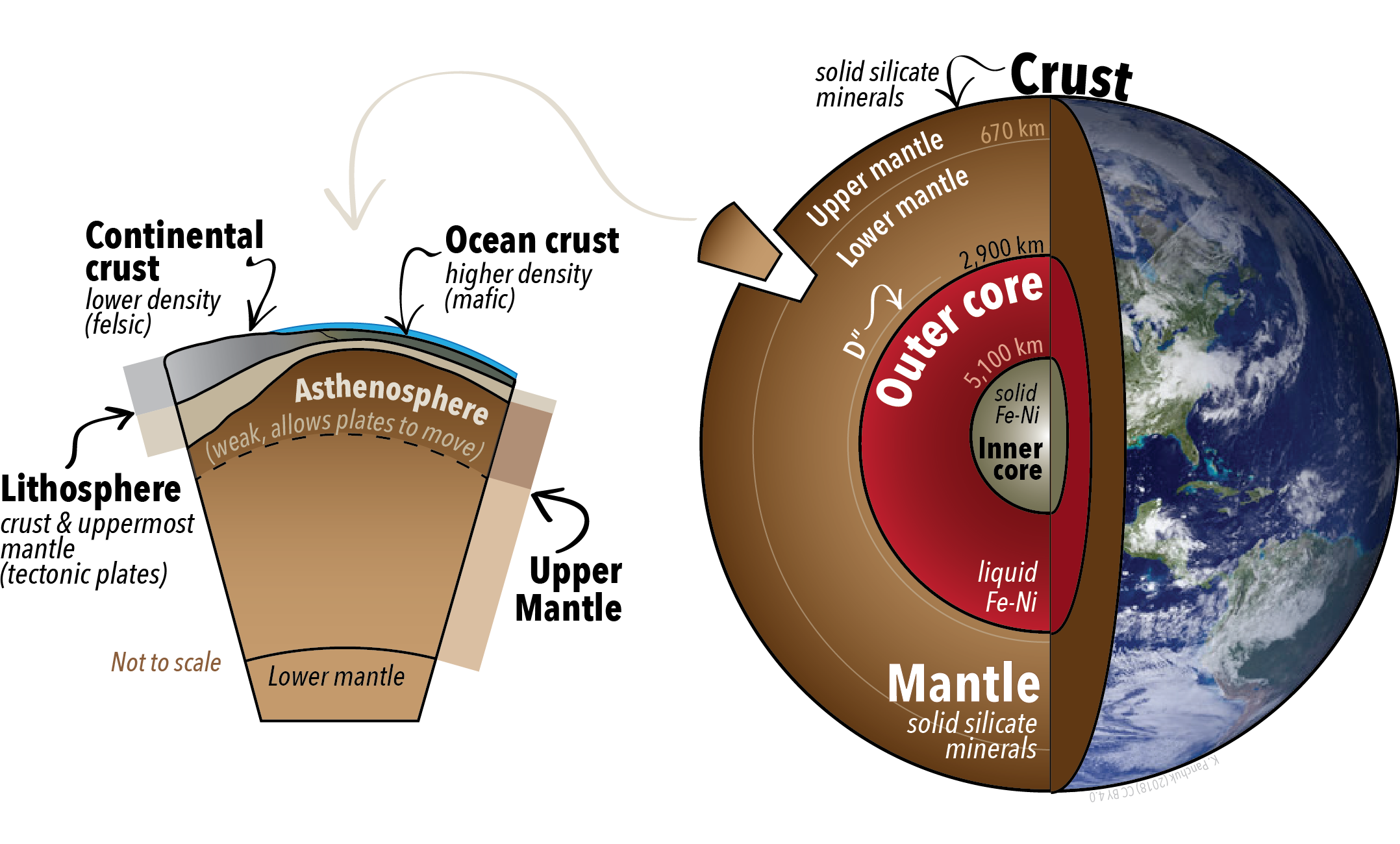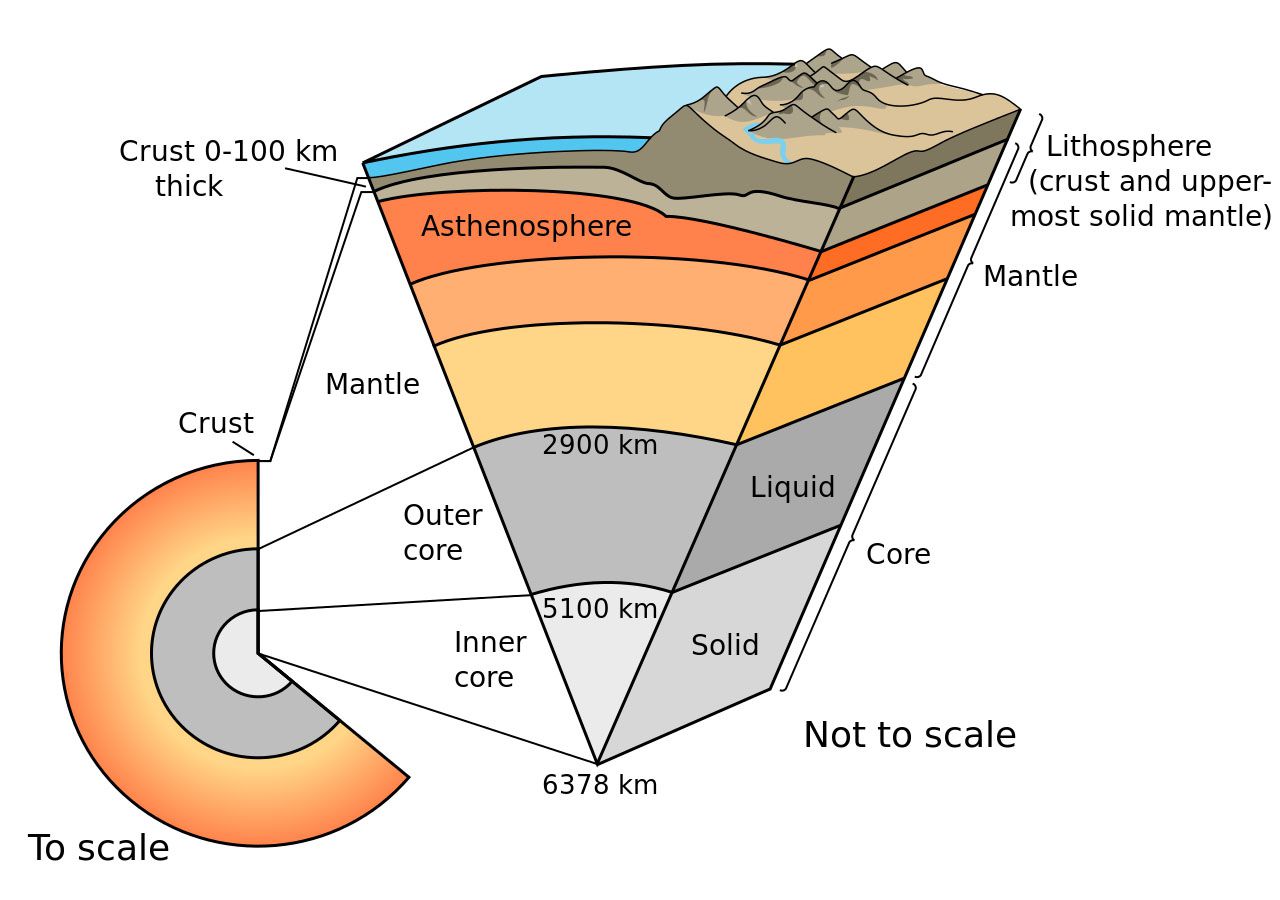Describe the Composition of the Mantle and Crust.
The hotter fluid mantle causes the less dense crust to rise which consequently results in the transfer of heat. The external layers of the solid Earth from the crust to the lower mantle are the main actors involved in the plate tectonics drama.

The Composition And Structure Of Earth Physical Geography
It is composed of mostly molten silicate-rich rocks that act as a very viscous fluid.

. The highest temperatures occur where the mantle material is in contact with the heat-producing core. Oxygen 466 percent by weight. The mantles structure is mostly silicates with a density ranging from 32 to 57 gcm 3.
It is several hundred miles in depth and like the Earths crust contains various types of minerals. Because the mantle and crust are made of rock the transfer of heat is through convection. The crust and the uppermost part of the mantle are called the lithosphere.
Tarbuck Earths crust is made up of several elements. Crust - 5 to 70 km thick. The Layers Of Earth Are Based On What Two Sets Of CharacteristicsThe layers of Earth are based on what two sets of characteristics.
Crust composed of light silicates Na K Al etc mantle of heavier silicates Fe Mg core of dense metals Fe Ni. 6 What is the composition of each layer of the earth. The discontinuity between the hydrosphere and crust is termed as the Conrad.
12 What does the asthenosphere do. By and large the portions of the crust that poke above the sea to form land consist of continental crust. It has different temperatures at different depths.
Lutgens and Edward J. If you were to drill into this you would find rock with an overall composition similar to granite - a rock rich in the minerals feldspar and quartz. The Earths mantle is the widest part of the planet.
The mean density of the materials in the crust is 3gcm3. Describe the composition location and functionality of the following layers of the Earth crust mantle. Directly beneath the Earths crust is the mantle.
Most abundant silicates are feldspars plagioclase 39 and alkali feldspar 12. The Earths crust only comprises 1 of the planets total composition. Sodium 28 percent potassium 26 percent and magnesium 21 percent.
Chemical composition and physical propertiesWhat are the layers of the earth and its characteristicsThe layers of Earth are. Major constituent elements of crust are Silica Si and Aluminium Al and thus it is often termed as SIAL Sometimes SIAL is used to refer Lithosphere which is the region comprising the crust and uppermost solid mantle also. 10 What are compositional layers.
The crust and mantle have the same density but continental crust is more mafic than oceanic crust and the mantle The composition of the crust is more similar to the core as compared to the mantle and the mantle is more similar to continental crust as compared to oceanic crust The mantle and the crust are less dense than the core but the mantle is more mafic than. 8 What is the scientific definition of asthenosphere. Earths mantle is a layer of silicate rock between the crust and the outer core.
The major constituent elements of the mantle are Silicon and Magnesium and hence it is also termed as SIMA The Core. The rest of the silicate family comprises 3 of the crust. It has a thickness of 2900 kilometres making up about 84 of Earths volume.
Earths mantle is thought to be composed mainly of olivine-rich rock. The mantle lies just beneath the Sima. What is the composition of the crust.
It makes up 70 of Earths volume in. The rock in the top portion of the mantle is hard but it becomes softer and melts as it descends. Describe the composition location and functionality of the following layers of the Earth crust mantle.
The temperature is lowest immediately beneath the crust and increases with depth. Other common silicate minerals are quartz 12 pyroxenes 11 amphiboles 5 micas 5 and clay minerals 5. Describe the Earths structure in terms of both chemical composition and physical properties.
It has a mass of 401 1024 kg and thus makes up 67 of the mass of Earth. The mantle is the part of the Earths interior between the outer core and the crust. More than 90 on the crust is composed of silicate minerals.
Explain why geologists believe that the Earths core is made mostly of iron. For the generation of the trace element characteristics of the EM sources it is assumed that depleted lithospheric mantle Salters and Stracke 2004 together with oceanic crust consisting of a mixture of 40 MORB Sun and McDonough 1989 50 gabbro Hart et al 1999 10 altered MORB Staudigel et al 1996 and with fragments of eroded lower continental crust and. 13 What is crust.
9 Which correctly describes the asthenosphere. 7 What is the asthenosphere and describe its characteristics. The crust is the outermost portion of the Earth which is comprised of three layers.
It has a thickness of 2900 kilometers. The surface of the Earth is the top of the crust - whether one is under the sea or on land. The movement of these rocks is what is responsible for plate tectonics and.
The majority of the mantle is made up of magma a semi-molten rock. The Earths mantle is a roughly 1800 mile 2900 km thick shell of compressed and heated rock beginning below the Earths crust lithosphere which extends 31 miles 5 km below the ocean floor and 19 to 31 miles 30 to 50 km below the continents. It is predominantly solid but on geologic time scales it behaves as a viscous fluid sometimes described as having the consistency of.
The mantle is made up of extremely hot and. Chemical composition - crust and mantle. 11 Why is the asthenosphere liquid.
In this chapter I describe their chemical composition and introduce the principal geodynamic processes occurring within and.

The Composition And Structure Of Earth Physical Geography

3 1 Earth S Layers Crust Mantle And Core Physical Geology First University Of Saskatchewan Edition

No comments for "Describe the Composition of the Mantle and Crust."
Post a Comment